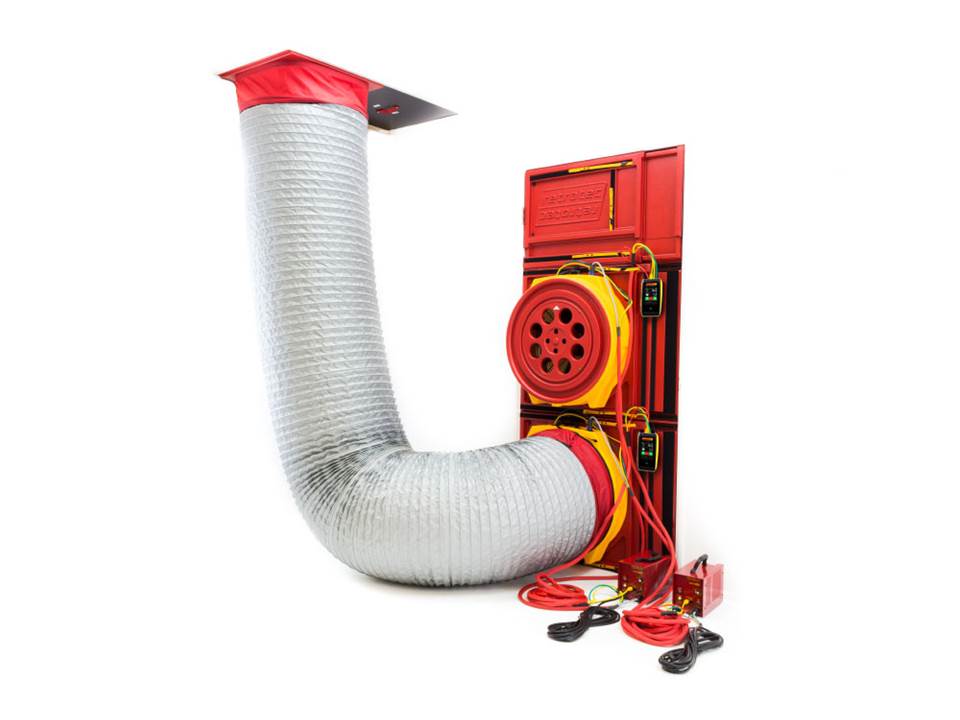NFPA Enclosure Integrity Testing
Enclosure integrity testing uses a Blower Door to measure
the total leakage area of rooms protected by fire suppression systems. The
measured leakage area from the Blower Door test can then be used to estimate
retention times for various clean agent fire extinguishing systems installed in
the protected room. Procedures for conducting enclosure integrity tests with a
Blower Door are contained in Appendix C of NFPA 2001.
Some rooms within a building house important equipment or control systems that cannot be serviced by liquid based fire extinguishing systems (i.e. data centers, control rooms, security rooms, laboratories, etc.). Effectiveness of a fire suppression system depends upon the enclosures’ integrity. The integrity of a room is defined as how well the enclosure retains the gaseous suppressant, without excess air leakage. Retention of the correct concentration of gas for the correct retention period is essential for the fire suppression systems effectiveness. To make sure this is the case, it is necessary to have regular room integrity tests. Room Integrity tests are a requirement of NFPA2001, BS5306 and Insurance companies to validate your insurance policies.
Based on the results of the blower door enclosure integrity test, we can calculate results for agent retention time and peak pressure during hold time based on the measured air leakage. We then calculate and present the results in accordance with a number of standard enclosure air leakage testing procedures. Our report containing measured and calculated results in accordance with the chosen standard testing procedure (NFPA2001 -2012 edition, ISO14520-2006 edition, EN15004-2008 edition). Furthermore, we test the installed pressure relief vents to verify that the venting area is enough to maintain the enclosure structural integrity. Most important, if your enclosure fails the room integrity test, we as building scientist are often better equipped and trained to locate the source of the air leakage than typical fire suppression installation companies.
The Enclosure Integrity Test does two things.
1. Determines the leakage of the enclosure with any pressure relief vents open which allows an estimate of the maximum peak pressure to be made.
2.Determines the leakage of the enclosure with any pressure relief vents shut or as they would be during the hold time (usually 10 minutes) to estimate the time the agent will be held in the vicinity of the hazard that is being protected.
Please complete the form below to schedule your building's Enclosure Integrity test.
Some rooms within a building house important equipment or control systems that cannot be serviced by liquid based fire extinguishing systems (i.e. data centers, control rooms, security rooms, laboratories, etc.). Effectiveness of a fire suppression system depends upon the enclosures’ integrity. The integrity of a room is defined as how well the enclosure retains the gaseous suppressant, without excess air leakage. Retention of the correct concentration of gas for the correct retention period is essential for the fire suppression systems effectiveness. To make sure this is the case, it is necessary to have regular room integrity tests. Room Integrity tests are a requirement of NFPA2001, BS5306 and Insurance companies to validate your insurance policies.
Based on the results of the blower door enclosure integrity test, we can calculate results for agent retention time and peak pressure during hold time based on the measured air leakage. We then calculate and present the results in accordance with a number of standard enclosure air leakage testing procedures. Our report containing measured and calculated results in accordance with the chosen standard testing procedure (NFPA2001 -2012 edition, ISO14520-2006 edition, EN15004-2008 edition). Furthermore, we test the installed pressure relief vents to verify that the venting area is enough to maintain the enclosure structural integrity. Most important, if your enclosure fails the room integrity test, we as building scientist are often better equipped and trained to locate the source of the air leakage than typical fire suppression installation companies.
The Enclosure Integrity Test does two things.
1. Determines the leakage of the enclosure with any pressure relief vents open which allows an estimate of the maximum peak pressure to be made.
2.Determines the leakage of the enclosure with any pressure relief vents shut or as they would be during the hold time (usually 10 minutes) to estimate the time the agent will be held in the vicinity of the hazard that is being protected.
Please complete the form below to schedule your building's Enclosure Integrity test.
